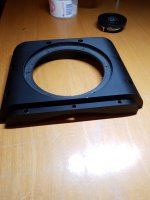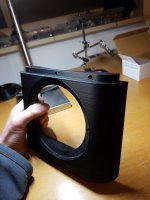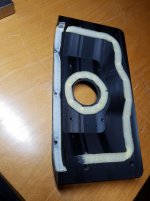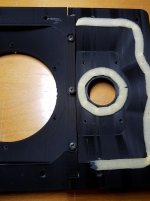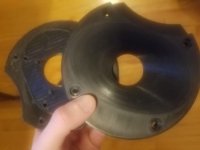Thanks for liking my work guys, that really gives me energy for my next project 🙂
@ Pultzar : I used Fusion360 to design the baffles.
@ Zonneschimmel : The baffles are attached with a high-damping polymer adhesive.
@ Pultzar : I used Fusion360 to design the baffles.
@ Zonneschimmel : The baffles are attached with a high-damping polymer adhesive.
@ Zonneschimmel : The baffles are attached with a high-damping polymer adhesive.
Is it possible to remove the drivers after attaching the baffle to the box?
😀 Yes, the drivers can be mounted/removed by removing the bottom panel.
There is a thin foam-tape gasket between the bottom panel and the baffle+box.
All other joints are made with adhesive (polymer between baffle and box, and wood glue between the layers).
There is a thin foam-tape gasket between the bottom panel and the baffle+box.
All other joints are made with adhesive (polymer between baffle and box, and wood glue between the layers).
Last edited:
Fantastic work Jeroen!
Did you print the baffles in multiple pieces? If so how did you create the "joint" in F360 and what adhesive did you use? I'd like to start printing baffles too, but the Ender 3 can only print small ones in one piece.
Did you print the baffles in multiple pieces? If so how did you create the "joint" in F360 and what adhesive did you use? I'd like to start printing baffles too, but the Ender 3 can only print small ones in one piece.
Hello Brandon,
First i would like to thank you for your creating this topic, without it i would not even be doing CAD design and 3D printing. Before this, i had no experience with CAD software at all, and i bought my 3D printer just to print your waveguides. 😀
First i just printed your waveguides, but then i realized that if could somehow integrate your WG profile into a baffle, i could get a lot smaller center distance between the drivers, because i don't need the mounting flange that way and i could also partially overlap the flange of the midrange (when rear-mounted)
So i learned how to use Fusion 360.🙂
The Baffles are printed in one piece with my Ender 3 Pro, so i was limited to a maximum of 250mm in height, but this was enough for these speakers(their dimensions are 250 x 200mm
I also want to make a larger baffle, so i printed a prototype of a two-piece model (pictures below).
The two pieces are held together by 3 screws in this case, sealed with foam tape but i think that a 2K epoxy glue will also do a very good job.
However i'm leaning towards just buying a larger printer for this purpose, as they are getting cheaper and cheaper these days.
I experimented a lot with the slicer settings, print orientation and nozzle sizes.
The best results where obtained when printing the baffles standing right up instead of laying flat on the bed surface, the only downside with this orientation is that the beginning of the WG throat will not be perfectly round, but a little bit "stepped" because of the layers.
I found a solution by reducing the throat diameter in the CAD drawing (by 0.5mm or so), and sanding it back to the required diameter afterwards, so that it fits perfectly around the tweeter roll surround.
Printing with a 0.4mm nozzle gave me a little bit nicer surface finish, but it takes a lot of time.
Using a 0.6mm nozzle cuts print time in half (or more, depending on layer height) and still gives a nice surface. Also the infill was a lot stronger with a larger nozzle.
Next project will be to print a whole cabinet in one piece.
Drivers will be Bliesma T25B (in WG) and Satori MR13/16 (hope that they will release the Textreme midrange version soon)
Greetings from Holland
Jeroen
First i would like to thank you for your creating this topic, without it i would not even be doing CAD design and 3D printing. Before this, i had no experience with CAD software at all, and i bought my 3D printer just to print your waveguides. 😀
First i just printed your waveguides, but then i realized that if could somehow integrate your WG profile into a baffle, i could get a lot smaller center distance between the drivers, because i don't need the mounting flange that way and i could also partially overlap the flange of the midrange (when rear-mounted)
So i learned how to use Fusion 360.🙂
The Baffles are printed in one piece with my Ender 3 Pro, so i was limited to a maximum of 250mm in height, but this was enough for these speakers(their dimensions are 250 x 200mm
I also want to make a larger baffle, so i printed a prototype of a two-piece model (pictures below).
The two pieces are held together by 3 screws in this case, sealed with foam tape but i think that a 2K epoxy glue will also do a very good job.
However i'm leaning towards just buying a larger printer for this purpose, as they are getting cheaper and cheaper these days.
I experimented a lot with the slicer settings, print orientation and nozzle sizes.
The best results where obtained when printing the baffles standing right up instead of laying flat on the bed surface, the only downside with this orientation is that the beginning of the WG throat will not be perfectly round, but a little bit "stepped" because of the layers.
I found a solution by reducing the throat diameter in the CAD drawing (by 0.5mm or so), and sanding it back to the required diameter afterwards, so that it fits perfectly around the tweeter roll surround.
Printing with a 0.4mm nozzle gave me a little bit nicer surface finish, but it takes a lot of time.
Using a 0.6mm nozzle cuts print time in half (or more, depending on layer height) and still gives a nice surface. Also the infill was a lot stronger with a larger nozzle.
Next project will be to print a whole cabinet in one piece.
Drivers will be Bliesma T25B (in WG) and Satori MR13/16 (hope that they will release the Textreme midrange version soon)
Greetings from Holland
Jeroen
Attachments
Yeah I didn't know anything about CAD or 3D printing before this either, and I've come to really like designing things in CAD. I've even designed my sauna, compound saw cabinet, and hardware shelving in CAD because I can make sure everything fits right before I start cutting wood.
Your comments reminded me of a couple things I should share with everyone. I use a 0.4mm nozzle. Regarding your comment on CTC, I purposely put the screw holes where they were so you could route into the waveguide's mounting flange if you wanted to get drivers closer. You could probably route a 1/4" and still have enough flange for a good seal.
Your comments reminded me of a couple things I should share with everyone. I use a 0.4mm nozzle. Regarding your comment on CTC, I purposely put the screw holes where they were so you could route into the waveguide's mounting flange if you wanted to get drivers closer. You could probably route a 1/4" and still have enough flange for a good seal.
Poll for you all regarding mouth shape. While the best of my designs have very good top octaves, it is possible going with a circular mouth might it improve it a bit. Would the improvement be worth it at the cost of worse center-to-center between drivers? Should I pursue this? Or are the majority of you satisfied with the top octave performance of the elliptical mouths and prefer the tighter ctc it allows?
Poll for you all regarding mouth shape. While the best of my designs have very good top octaves, it is possible going with a circular mouth might it improve it a bit. Would the improvement be worth it at the cost of worse center-to-center between drivers? Should I pursue this? Or are the majority of you satisfied with the top octave performance of the elliptical mouths and prefer the tighter ctc it allows?
I just measured my SB26 on your waveguide - no top end issues what so ever. I personally like the elliptical look and prefect the lower CTC spacing - I’m just not as crafty at making the elliptical recess/cutout 🙂
I am personally a fan of the tight center to center spacing. @Dkalsi, I addressed my concerns with ellipses by making circular faceplates for my waveguides. See the attached image, the midrange gets right up to the waveguide edge and helps seal it to the cabinet. The routing for the through baffle tweeter cut is a simple pill shape.
Attachments
I just measured my SB26 on your waveguide - no top end issues what so ever. I personally like the elliptical look and prefect the lower CTC spacing - I’m just not as crafty at making the elliptical recess/cutout 🙂
+1 🙂
I too, prefer to lower as much as possible ctc distance as long as we can preserve good polar response of the elliptical wave guides.
Another vote for the elliptical, however I wish the mounting flange was rectangular instead of elliptical to facilitate recessing it into the cabinet.
Another vote for the elliptical, however I wish the mounting flange was rectangular instead of elliptical to facilitate recessing it into the cabinet.
Easy: https://www.diyaudio.com/forums/mul...aveguides-cnc-3d-printing-60.html#post6375776
Just fantastic results on the Bliesma T25B on your waveguides! It doesn't get much better than that. The performance above >10KHz is the best I've ever seen. I know a lot of people don't care about >10KHz and especially >20KHz performance, but I personally find it very important and underrated. Thank you augerpro for your amazing work.
Thanks! Hope to see them in one of your designs soon!
Speaking of designs, I now have my own pair of T25Bs and will be ordering some Textreme Satori woofers to match them with. And a friend of mine is finishing his home theater and is toying with idea of going DIY for the speakers, which would mean ceramic SB26 matched to SB17s. So I might have two designs in process soon.
Thanks for the feedback regarding mouth shape, I thought elliptical was the best balance of compromises, but wanted to make sure everyone else agreed.
Speaking of designs, I now have my own pair of T25Bs and will be ordering some Textreme Satori woofers to match them with. And a friend of mine is finishing his home theater and is toying with idea of going DIY for the speakers, which would mean ceramic SB26 matched to SB17s. So I might have two designs in process soon.
Thanks for the feedback regarding mouth shape, I thought elliptical was the best balance of compromises, but wanted to make sure everyone else agreed.
Hi folks,
Today I've tried for the first time to dismount the SB26ADC faceplate.
So I've unscrewed the 4 screws and raised the faceplate.
I've been very astonished to see the that the aluminium cone and its 'under' plate came out.
So I've started by sweating a bit, and just re assemble it as is.
Is it normal ? Do I have lost a tweeter ?
Today I've tried for the first time to dismount the SB26ADC faceplate.
So I've unscrewed the 4 screws and raised the faceplate.
I've been very astonished to see the that the aluminium cone and its 'under' plate came out.
So I've started by sweating a bit, and just re assemble it as is.
Is it normal ? Do I have lost a tweeter ?
shining31 - same thing here. I just put them back together, being careful to not damage the voice coil when sliding it back together. No issues.
Augerpro - Part of the reason I chose to use your SB26 5" waveguides was for the potential hands-on learning experience. I understand the general concepts of how waveguides impact performance, but I'm a very visual learner.
Any chance for one of your drivers you could do a chart overlay between 5 and 8" version so that I can better visualize how the rolloffs/dispersion changes? Perhaps SB26ADC 5" and 8", on-axis, 30°, 60°? So 6 traces on 1 chart, which would help me visualize things better.
Augerpro - Part of the reason I chose to use your SB26 5" waveguides was for the potential hands-on learning experience. I understand the general concepts of how waveguides impact performance, but I'm a very visual learner.
Any chance for one of your drivers you could do a chart overlay between 5 and 8" version so that I can better visualize how the rolloffs/dispersion changes? Perhaps SB26ADC 5" and 8", on-axis, 30°, 60°? So 6 traces on 1 chart, which would help me visualize things better.
I would be very interested in using one of the T25B waveguides, but I really don't like the idea of an exposed beryllium dome. Is it possible to place the mesh grill on the waveguide? Or, is the waveguide too elliptical for it to fit well already?
shining31> the faceplate and the diaphragm plate separate, just use a razor or butter knife to go around the edge and pry them apart. Sometimes they are tight, sometimes the faceplate just comes right off and the diaphragm stays put.
black300zx> I'll see what I can do, I'm trying to get these cabinets finished up for my next round of construction methods testing
Paul> the mesh grill must be removed so the the throat can be small. Response wouldn't be very good if it had a gigantic throat.
black300zx> I'll see what I can do, I'm trying to get these cabinets finished up for my next round of construction methods testing
Paul> the mesh grill must be removed so the the throat can be small. Response wouldn't be very good if it had a gigantic throat.
I should have explained myself better. What I meant was to remove the mesh grill from the tweeter, mount the tweeter to the waveguide and then place (glue?) the grill on the waveguide over the dome. Is this possible?
- Home
- Loudspeakers
- Multi-Way
- Open source Waveguides for CNC & 3D printing!
